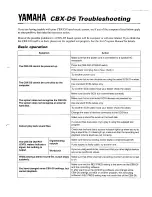
19
for display by depressing and releasing the button once
(less than 5 seconds); the LED will flash the Fault Code
History (up to 5 fault codes from newest to oldest). The
Fault Code History is retained between power cycles until
cleared. A fault code is added to the history log as it is
encountered if it differs from the most recent history log
item. If the history log is already full, then the oldest entry is
dropped from the log and the remaining entries are moved
down in the Fault Code History so that the new fault can be
added to the Fault Code History as the most recent fault.
NOTE: Do not hold for longer than 5 seconds.
Holding the button for 5 seconds or higher will
erase the memory!
Resetting From Lockout
An external lockout occurs if the integrated ignition control
determines that a measurable combustion cannot be
established within three (3) consecutive ignition attempts.
If flame is not established within the four (4) second trial for
ignition, the gas valve is de-energized, 30 second inter-
purge cycle is completed, and ignition is re-attempted. The
control will repeat this routine three times if a measurable
combustion is not established. The control will then shut off
the induced draft blower and go into a lockout state.
If flame is established but lost, the control will energize
the circulator blower at the heat speed and then begin a
new ignition sequence. If flame is established then lost on
subsequent attempts, the control will recycle the ignition
sequence.
The diagnostic fault code is 1 flash for a lockout due
to failed ignition attempts. The integrated control will
automatically reset after one hour, or it can be reset by
removing the thermostat signal or disconnecting the
electrical power supply for over five seconds.
IMPORTANT NOTE: If you have to frequently reset
your gas/electric package unit, it means that a
problem exists that should be corrected. Contact
a qualified servicer for further information.
Pressure Sensor
The pressure sensor is mounted near induced draft blower.
Its function is to regulate the induced draft blower’s speed
in order to maintain proper air-fuel ratio for clean and
reliable combustion. The electrical output signal from the
sensor is expected to be proportional to the magnitude of
the differential pressure between the inducer inlet negative
pressure and the ambient air pressure. The pressure
sensor also guards against insufficient airflow (combustion
air and flue products) through the heat exchanger.
At the beginning of a call for heat, the control ensures the
inducer is in an off state, then checks the pressure sensor
output for the proper null offset value. If the pressure
sensor output is outside the acceptable range for the null
value, the control enters a five minute lockout. After the
lockout timer has expired, the control resumes normal
operation.
During inducer operation, including all operating modes
except for the null test, the control monitors the pressure
sensor output for expected values. The control limits
during normal operation are expected to be within certain
tolerances of the target pressures. In response to a
pressure sensor span error, the control enters a five minute
lockout. After the lockout timer has expired, the control
resumes normal operation.
Primary Limit
A primary limit will open due to excessive supply air
temperatures. This can be caused by a dirty filter,
excessive duct static, insufficient air flow, or a faulty limit.
Check filters, total external duct static, blower motor, blower
motor speed tap (see wiring diagram), and limit. This limit
will automatically reset once the temperature falls below a
preset level.
If a limit switch opens, the gas valve is immediately de-
energized, the induced draft and air circulating blowers
are energized. The induced draft and air circulator blowers
remain energized for 5 minutes or until the limit switch re-
closes, whichever happens first.
NOTE: If the primary limit opens three (3) times
within the same call for heat, the ignition control
will lock out for one (1) hour with the air
circulating blower energized at high heat speed.
Flame Detected with Gas Valve Closed
If flame is detected with the gas valve de-energized, the
combustion and air circulator blowers are energized. The
control can be reset by removing the power supply to the
unit or it will automatically reset after one hour. Miswiring is
the probable cause for this fault. The initial lockout period is
5 minutes. After that time, the control continues to monitor
the flame sense input and resumes normal operation when
flame is no longer sensed.
Low Flame Signal
Under some conditions, the fuel or air supply can create a
nearly invisible coating on the flame sensor. This coating
acts as an insulator causing a drop in the flame signal. If
the flame signal drops below a predetermined value, the
ignition control will display an error code of (1) flash on the
amber diagnostic LED. The unit will continue to operate
until the control can no longer detect flame.
Burner Temperature Switch
The burner temperature switch is mounted on the burner
box assembly to monitor the burner box temperature. It is
normally closed (electrically), auto-reset switch. This switch
guards against the burner flames not being properly drawn
into the heat exchanger.
The control senses an open blocked burner switch,
indicating that the burner temperature/pressure has
exceeded its set point. The control de-energizes the gas
valve, energizes the inducer to the pre-purge setting and
energizes the indoor blower. The initial lockout period is five














































